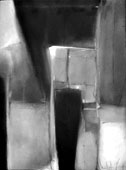|

Comment
on this story
What:
Grady Kimsey and Christopher Terry
Where:
The Hanson Gallery, 5607 Kingston Pike (call 584-6097 for hours)
When:
Through Nov. 12, 2003.
Opening reception Friday, Oct. 11 from 5:30 - 8 p.m.
|
|

Knoxvillians past and present exhibit their art
by Heather Joyner
I have always enjoyed the work of artists represented by Diane and Doug Hanson, even when space for display is limited. I am therefore especially pleased that the Hanson Gallery's current show—presenting assemblages by Grady Kimsey and paintings by Christopher Terry—is allowed adequate breathing room. A thriving framing business as well as a place for art, the gallery presumably works hard to balance pieces that come and go within a sort of visual maelstrom. And its efforts pay when we can immerse ourselves without distraction in what Kimsey and Terry have to offer.
Distinguished as one of UT's first art students (beginning in 1947), Kimsey became a teacher after relocating to Florida in the 1960s. Before moving southward with a wife and two sons, Kimsey worked as a set designer and choreographer for the University's Carousel Theater. Then, as now, what could be a lively interaction between art and drama departments was not necessarily encouraged. It is therefore to his credit that Kimsey has exercised creativity in both areas, and his affinity for theater is evident in assemblages produced throughout the past 20 years or so. He has also remained connected to Knoxville.
As difficult as Kimsey's artwork is to define, it nevertheless appeals to a wide range of viewers. His generally small figures with ceramic heads populate what the artist calls "tableaux" made up of found objects, paint, fabric, etc. Like Hopi kachina dolls, Kimsey's figures at first glance seem like toys but possess a talismanic quality. What could be far too cute or precious (in part due to scale) is instead striking and often humorous. Says the artist, "I notice that people with a sense of humor see humor in them." But despite Kimsey's suggestion that he creates his pieces "in a lighthearted spirit," the personal narrative they allude to reflects greater depth. Perhaps he is hesitant to force meaning upon others. He remarks, "the trite way to put it is that my past dictates what I bring to [my work], as does the past of each viewer." Whatever the case, Kimsey's constructions function on a number of levels.
Kimsey's "The Tuesday Chorus" is particularly stage-like, with a drawer set on end behind a cluster of figures with faces reminiscent of ones painted by Arshile Gorky. His "Tableau: The Wait" has a similar tone but more movement. Featuring an exquisitely pieced-together base and frayed banner held up by spindly lengths of wood, it revolves around five lyrical personages that seem up to something important—although we do not know what. "Tableau: Monitor's Call" finds "characters" in a cart being pulled by a strange blue animal. Despite being hemmed-in and captive, they resemble celebrants on their way to a festival.
Like actors in a play, Kimsey's figures seem meant to be viewed from a specific angle. Individual figures like the one in "After October" are more totemic and Native American in feel. Whether grouped or standing alone, Kimsey's subjects often carry flags or staffs that lend them a certain majesty. Says Sarasota Gallery Director Marcia Corbino, "A viewer's personal interest in spiritual forces, primitive cultures, historical conflicts, or contemporary artifacts will suggest a meaning or a metaphor to activate the content of each sculpture."
Serving as backdrop for Kimsey's assemblages are Terry's canvases and works on paper. They are, however, much more than a background presence. With masterfully handled color that saturates surface and becomes surface itself, Terry's work is luminous. If we divide abstract expressionist painting into two camps—as does art historian Edward Lucie-Smith—we could call one branch "energetic and gestural" and the other "more purely abstract and tranquil."
Terry's painting is clearly the latter, with a nod toward artist Mark Rothko. Occasional pencil marks and scratches are like notes to the artist within a given piece, and they seem to position him or somehow help him navigate within his compositions. And one need not be a painter to appreciate the way Terry's pigment is set down and man-ipulated. In short, the work is beautiful. Frames perfectly matched to their contents "gild the lily" in a sense, yet it's mostly a matter of how much harmony we can stand.
Speaking of harmony, I'd like to see Terry try colors he's maybe not so comfortable using. It also seems time for him to paint something truly large. His recent attempts to add grit to his surfaces and incorporate pieces of wood and/or patches with letters do not feel as confident as they might, and another shift in approach may be in order.
Kimsey says, "I have a personal philosophy that says when you do something too long and it becomes sort of 'successful,' you start imitating yourself...it gets weaker with each piece." I'm happy to say that both Kimsey and Terry appear far too talented and resourceful to permit that to happen.

October 10, 2002 * Vol. 12, No. 41
© 2002 Metro Pulse
|